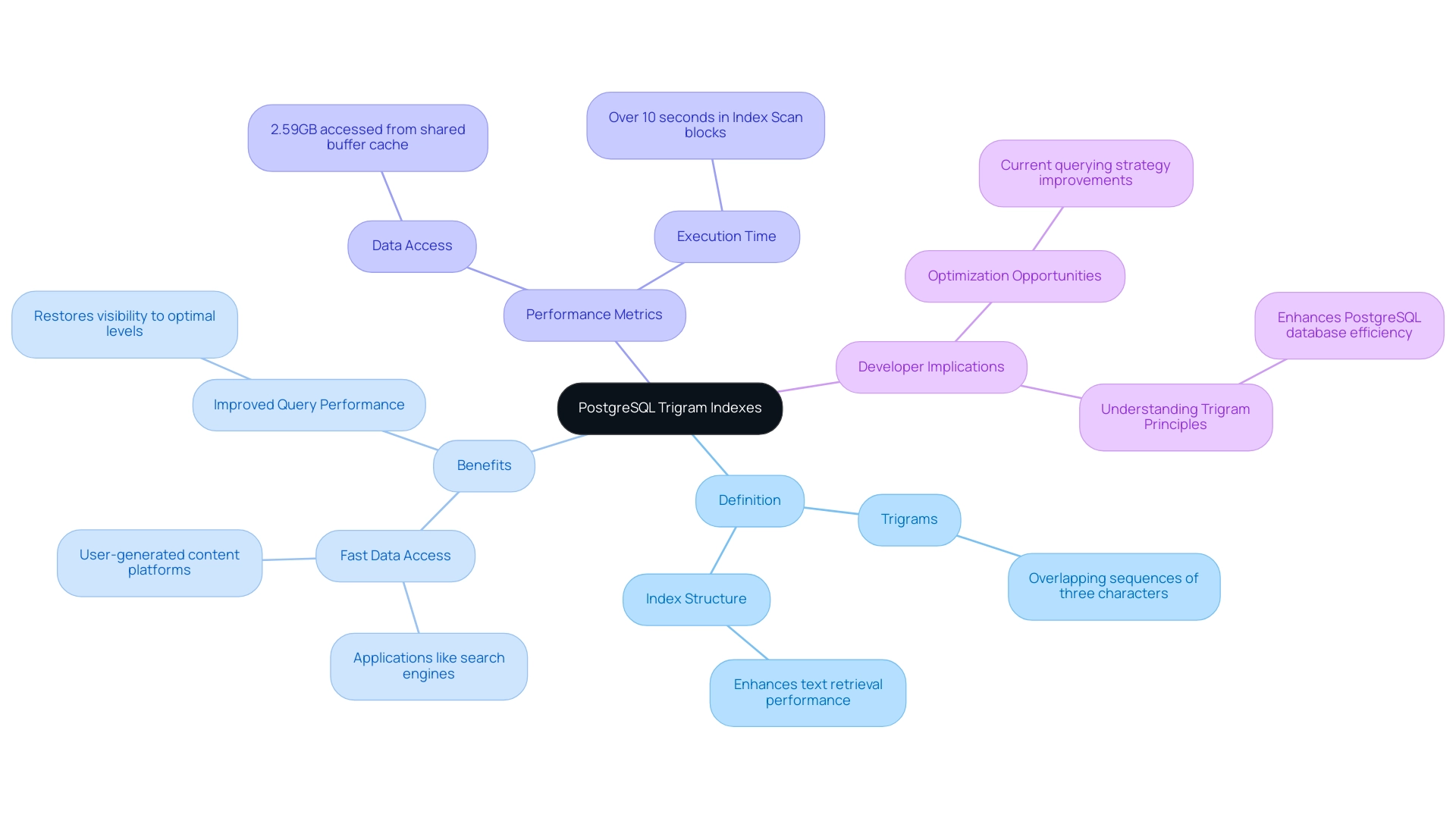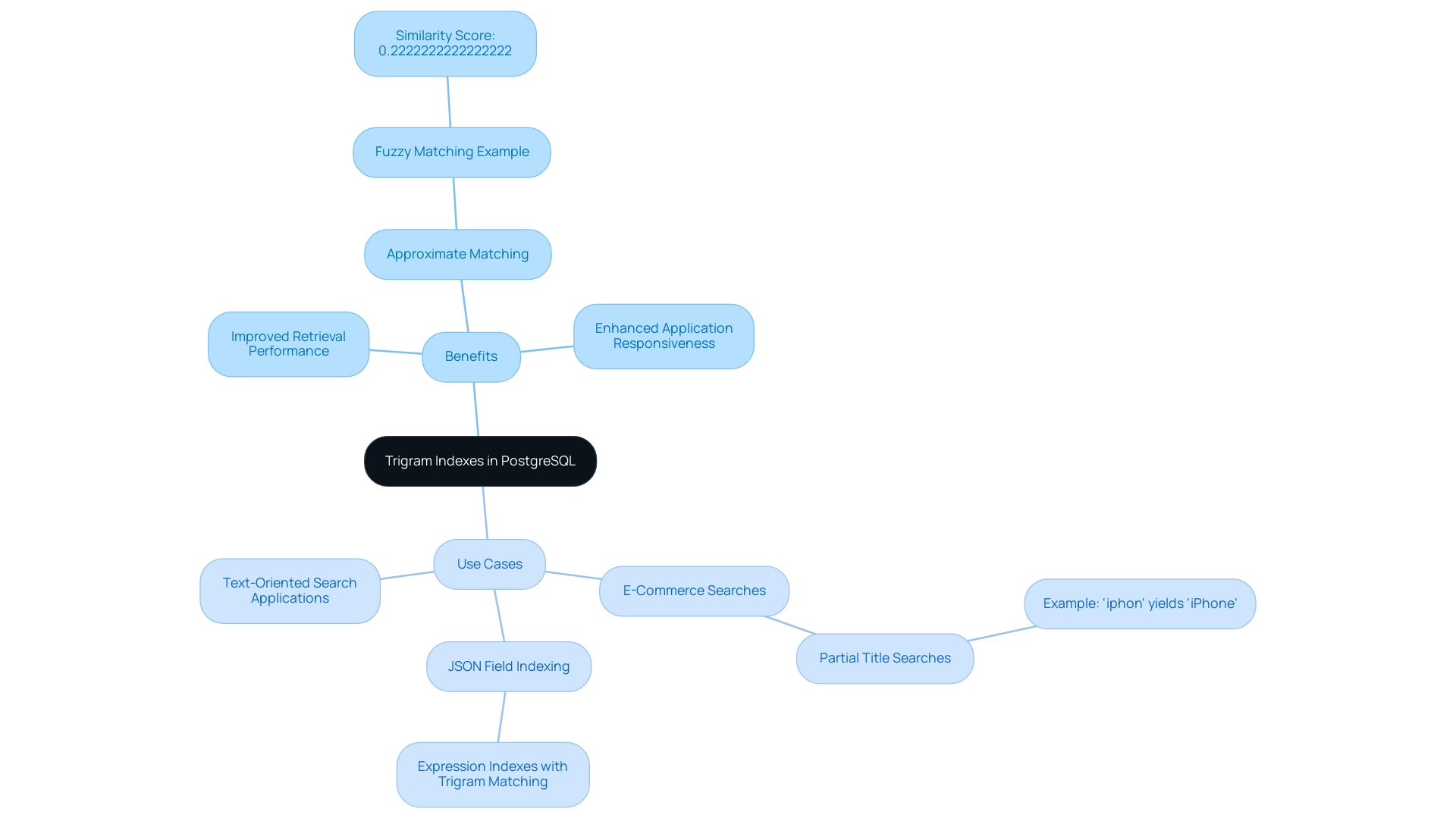Introduction
In the realm of database management, the quest for enhanced search efficiency has led to innovative solutions that redefine how text data is accessed and utilized. PostgreSQL Trigram Indexes stand out as a transformative tool, meticulously designed to accelerate text search performance by breaking down strings into overlapping sequences of three characters, or trigrams. This advanced indexing method not only addresses the challenges of fuzzy matching but also significantly improves query response times, making it indispensable for applications that rely on swift text retrieval.
As organizations increasingly seek to optimize their databases for performance and productivity, understanding the mechanics and benefits of Trigram Indexes becomes essential for developers aiming to refine their PostgreSQL implementations.
Introduction to PostgreSQL Trigram Indexes
The postgres trigram index structures in PostgreSQL are sophisticated data arrangements intended to greatly enhance text retrieval performance. By decomposing strings into overlapping sequences of three characters—known as 'trigrams'—the postgres trigram index facilitates more efficient searching, especially within large datasets or when fuzzy matching is necessary. This feature is crucial in scenarios where exact matches are not practical.
The use of a postgres trigram index demonstrates particular benefits for applications requiring fast text data access, such as search engines or platforms that manage user-generated content. Recent performance evaluations suggest that optimizing searches with three-character patterns can restore visibility and improve search efficiency to optimal levels, tackling the inefficiencies frequently linked to conventional indexing techniques. Notably, the total data accessed from the shared buffer cache was about 2.59GB, underscoring the substantial impact of these indexes on performance.
As highlighted in the case study titled 'Execution Time Breakdown of Queries,' over 10 seconds were spent in Index Scan blocks, indicating a significant opportunity for optimization in querying strategies. As Eresh Gorantla aptly puts it,
Such patterns aren't supported by B-tree indexes.
Grasping the principles of three-part structures is crucial for developers aiming to enhance their PostgreSQL databases by utilizing a postgres trigram index for text-focused requests, ultimately resulting in better efficiency and productivity in their applications.

Benefits and Use Cases of Trigram Indexes in PostgreSQL
Three-character references provide significant benefits, especially in improving retrieval performance and allowing approximate matching, which is essential for managing user requests efficiently. For instance, a similarity score of 0.2222222222222222 for the words 'weird' and 'word' demonstrates the effectiveness of fuzzy matching. On e-commerce platforms, users often look for items using partial or misspelled titles; a search term like 'iphon' will still yield pertinent results for 'iPhone' due to the advanced fuzzy matching features of specific structures.
This functionality not only improves user experience but also boosts application responsiveness. Moreover, expression indexes can be established on specific JSON fields using a postgres trigram index with three-gram matching, demonstrating the flexibility of three-gram structures in various applications. As Laurenz Albe suggests, "You can test for yourself by first running SET enable_seqscan=off; then PostgreSQL will try to avoid sequential scans if possible," highlighting the practical implications of these indexes.
Furthermore, three-gram structures are essential in data examination and reporting instruments that depend significantly on text-oriented searches. The integration of the postgres trigram index within PostgreSQL can markedly elevate both the efficiency of LIKE queries and overall application performance, making it an essential tool for modern database management.

How Trigram Indexes Work: Mechanisms and Implementation
The postgres trigram index in PostgreSQL is established using the CREATE INDEX command and the pg_trgm extension. Upon creation, PostgreSQL generates trigrams from each indexed string, optimizing them for swift retrieval. This innovative mechanism leverages a B-tree structure, which is essential for facilitating rapid lookups.
For instance, to create a Trigram Index on a 'description' column within a 'products' table, the following command is executed:
CREATE INDEX idx_trgm_description ON products USING gin (description gin_trgm_ops);
Such implementation dramatically enhances the database's ability to handle pattern matching and fuzzy inquiries, leading to substantial improvements in response times. Notably, users have reported a significant performance boost, with query times improving from over 10 seconds to just over 100 milliseconds.
As Michael Lewis aptly puts it, "A significant improvement: from over 10s to just over 100ms!" This transformation highlights the efficiency of the postgres trigram index in enhancing retrieval capabilities in PostgreSQL. Furthermore, examining approaches such as the case study named 'Single Query for All Text Columns' shows how specific indexing methods can improve search abilities across various text columns, further highlighting their importance as the database progresses with the most recent indexing strategies.
Limitations and Considerations of Using Trigram Indexes
Three-term references offer significant benefits, but they also have considerable drawbacks. The introduction of the postgres trigram index can notably increase storage requirements due to the additional data structures generated for the trigrams. For instance, while traditional indexing methods may be adequate for small datasets, the performance benefits of the postgres trigram index can diminish significantly in these scenarios.
A compelling case is highlighted by recent findings, which indicate that the addition of a Gist index reduced query time from 94 seconds to just 4.5 seconds, showcasing how traditional indexing might still be effective for smaller datasets. In fact, the initial search time for one text column was 90 seconds, which was reduced to 113 milliseconds when four columns were indexed, illustrating the dramatic performance improvements possible with appropriate indexing strategies. Furthermore, the overhead involved in maintaining the postgres trigram index during data modifications—such as inserts and updates—can lead to performance degradation if not managed effectively.
Consequently, it is essential for developers to thoroughly evaluate their particular use cases and dataset sizes to determine whether incorporating three-gram structures aligns with their efficiency and performance objectives. As Erwin Brandstetter succinctly states,
Sure, any B-tree Index with leading timestamp column < could be a more efficient choice in certain scenarios, particularly for cross join similarity scoring over recent data. Understanding these dynamics is essential for maximizing productivity and ensuring optimal database performance.
Integrating Trigram Indexes with Full-Text Search in PostgreSQL
The combination of three-gram structures with PostgreSQL's full-text retrieval features provides significant enhancements in functionality. This combination enables developers to harness the strengths of both systems, resulting in enhanced performance and user experience. Trigram Indexes excel at enhancing the speed of searches that require fuzzy matching, while full-text search effectively handles complex requests involving ranking and relevance.
For instance, a notable statistic reveals that increasing the single parameter from 64 to 256 can reduce response time significantly, from 4.5 seconds down to just 2 seconds. Additionally, the Gist index has been shown to reduce search time from 94 seconds to just 4.5 seconds, highlighting the overall indexing improvements. However, it's important to note that full-text retrieval in PostgreSQL can break words according to language rules, which may complicate inquiries for partial words.
To implement this integration, developers should:
- Create a postgres trigram index on relevant text columns.
- Utilize the postgres trigram index alongside full-text retrieval requests.
This method not only broadens the scope of exploration capabilities but also optimizes data retrieval efficiency, addressing a wider array of user queries and enhancing overall system performance. Furthermore, exploring Incremental View Maintenance (IVM) highlights the potential for improved efficiency in search functionality, as it allows materialized views to be automatically updated on any write to the source table.
Conclusion
PostgreSQL Trigram Indexes represent a significant advancement in database management, offering a powerful solution for enhancing text search performance. By breaking down strings into trigrams, these indexes enable efficient fuzzy matching and dramatically improve query response times. The ability to handle user-generated content and incomplete search terms effectively makes Trigram Indexes essential for modern applications, particularly in e-commerce and data analysis contexts.
While the benefits of implementing Trigram Indexes are substantial, it is also crucial to consider their limitations. Increased storage requirements and maintenance overhead during data modifications can present challenges that developers must navigate. A careful assessment of specific use cases and dataset sizes is necessary to determine the optimal indexing strategy, ensuring that the advantages of Trigram Indexes can be fully realized without compromising performance.
Integrating Trigram Indexes with PostgreSQL's full-text search capabilities further enhances search functionality, allowing for both rapid fuzzy matching and sophisticated query management. This combination not only optimizes data retrieval but also enriches the user experience, making it easier to handle complex queries. As the landscape of database management evolves, leveraging Trigram Indexes will undoubtedly lead to improved efficiency and productivity, empowering developers to meet the growing demands of data-driven applications.
Frequently Asked Questions
What is a postgres trigram index?
A postgres trigram index is a sophisticated data structure in PostgreSQL that enhances text retrieval performance by decomposing strings into overlapping sequences of three characters, known as trigrams.
How do postgres trigram indexes improve searching?
They facilitate more efficient searching, especially in large datasets or when fuzzy matching is required, making them crucial for scenarios where exact matches are impractical.
What are the benefits of using a postgres trigram index?
Benefits include improved retrieval performance, enhanced approximate matching capabilities, and increased efficiency for applications such as search engines and platforms managing user-generated content.
How effective are postgres trigram indexes in performance evaluations?
Recent evaluations suggest that optimizing searches with three-character patterns can restore visibility and improve search efficiency, addressing inefficiencies often linked to traditional indexing methods.
What insights were gained from the case study titled 'Execution Time Breakdown of Queries'?
The case study indicated that over 10 seconds were spent in Index Scan blocks, highlighting significant opportunities for optimization in querying strategies.
Can postgres trigram indexes handle fuzzy matching?
Yes, they are effective for fuzzy matching, as demonstrated by a similarity score example of 0.2222222222222222 for the words 'weird' and 'word', which shows their capability to return relevant results even with partial or misspelled terms.
How do postgres trigram indexes affect user experience on e-commerce platforms?
They allow users to find items using partial or misspelled titles, enhancing the search experience by yielding pertinent results, such as searching for 'iphon' returning results for 'iPhone'.
What flexibility do postgres trigram indexes offer for JSON fields?
Expression indexes can be established on specific JSON fields using a postgres trigram index with three-gram matching, showcasing their versatility in various applications.
How do postgres trigram indexes impact LIKE queries?
The integration of postgres trigram indexes can significantly elevate the efficiency of LIKE queries, improving overall application performance in text-oriented searches.
What practical advice is given regarding sequential scans in PostgreSQL?
Laurenz Albe suggests testing the performance by running SET enable_seqscan=off; to encourage PostgreSQL to avoid sequential scans if possible, highlighting the practical implications of using trigram indexes.




